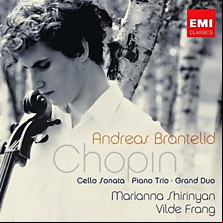BBC Review 1bj6o
Imbued with a youthful enthusiasm underpinned by interpretational maturity.
Charlotte Gardner 2010
The young Danish cellist, Andreas Brantelid, may only be in his early 20s, but he’s a fast-rising star. Amongst a myriad of achievements, he was the 2006 recipient of the Eurovision Young Musician of the Year award, and is currently on the BBC’s New Generation Artist scheme. His 2008 debut recording of concertos by Saint-Saens and Schumann stood out for its confident lyricism and lithe technique. For his second disc, he has ed forces with two other young rising talents: Vilde Frang, the young Norwegian violinist and protégée of Anne-Sophie Mutter, and the Armenian pianist Marianna Shirinyan.
Frédéric Chopin exhibited most of his compositional prowess as a composer of piano music, and never felt entirely comfortable working in other mediums. Much has been made of this fact, and possibly too much. One can hark on about how he was forced to enlist the help of the cellist August Franchomme as he wrote the cello part of his Grand Duo. Or, about how, even 14 years later as he penned his Cello Sonata, he was still complaining, “I write a little and cross out a lot.” One can also point out that the styles of these chamber pieces are a far cry from the subtle nuances and clean lyricism of his piano compositions. However, it’s still fabulous music, and all three works here are a gift for chamber musicians: they’re packed with dramatic possibilities, and everyone is given an equally fair crack of the melodic whip.
Brantelid’s ability to reach the emotional core of a work is as evident here as on his previous disc, particularly in the Sonata. There is more supple delivery of technical challenges too, whether silky-smooth double stopping, or fast runs executed with both precision and panache. Crucially, this is also a very successful chamber collaboration; the strings blend perfectly with each other in tone and balance, and are elegantly ed by Shirinyan, who knows when to provide a subtle cushion of colour and when to enjoy her many forays into the spotlight. The overall sound is warm, technically perfect, and imbued with a youthful enthusiasm that is underpinned by interpretational maturity.



